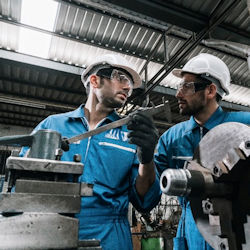Protective Clothing and Personal Protective Equipment
When higher-level controls are not available or are not fully capable of protecting the maintenance workers or operators they must rely on protective clothing, and personal protective equipment (PPE) as additional protective measures.
Protective Clothing is designed to shield the body from physical, chemical, thermal, or biological hazards through full-body coverage and includes the following:
- Coveralls or lab coats
- High-visibility vests or jackets
- Flame-resistant (FR) clothing
- Cut-resistant sleeves or jackets
- Chemical-resistant suits or aprons
- Thermal-insulated outerwear for cold environments
Personal Protective Equipment (PPE) is intended to protect specific parts of the body from targeted hazards and includes the following:
- Safety glasses or goggles
- Face shields
- Hard hats
- Hearing protection (earplugs or earmuffs)
- Respirators or dust masks
- Gloves (chemical-resistant, cut-resistant, electrical-rated)
- Steel-toed or metatarsal safety boots
Protective clothing and PPE can also create hazards, such as:
- A protective glove which can become caught on or between rotating parts, or a respirator facepiece which hinders the wearer's vision, for example, requires alertness and continued attentiveness whenever they are used.
- Other parts of the worker's clothing may present additional safety hazards. For example, loose-fitting long-sleeve shirts might possibly become entangled in rotating spindles or other kinds of moving machinery. Jewelry, such as bracelets and rings, can catch on machine parts or stock and lead to serious injury by pulling a hand into the danger area.
Knowledge Check Choose the best answer for the question.
6-8. Why should workers be cautious when wearing protective gloves near rotating machinery?
You forgot to answer the question!

